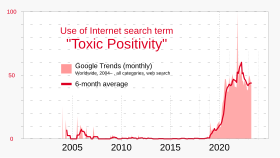Feelings are subjective self-contained phenomenal experiences. According to the APA Dictionary of Psychology, a feeling is "a self-contained phenomenal experience"; and feelings are "subjective, evaluative, and independent of the sensations, thoughts, or images evoking them". The term feeling is closely related to, but not the same as, emotion. Feeling may for instance refer to the conscious subjective experience of emotions. The study of subjective experiences is called phenomenology. Psychotherapy generally involves a therapist helping a client understand, articulate, and learn to effectively regulate the client's own feelings, and ultimately to take responsibility for the client's experience of the world. Feelings are sometimes held to be characteristic of embodied consciousness.
In psychology, a mood is an affective state. In contrast to emotions or feelings, moods are less specific, less intense and less likely to be provoked or instantiated by a particular stimulus or event. Moods are typically described as having either a positive or negative valence. In other words, people usually talk about being in a good mood or a bad mood. There are many different factors that influence mood, and these can lead to positive or negative effects on mood.
Positive psychology studies the conditions that contribute to the optimal functioning of people, groups, and institutions. It studies "positive subjective experience, positive individual traits, and positive institutions... it aims to improve quality of life."

A mood swing is an extreme or sudden change of mood. Such changes can play a positive part in promoting problem solving and in producing flexible forward planning, or be disruptive. When mood swings are severe, they may be categorized as part of a mental illness, such as bipolar disorder, where erratic and disruptive mood swings are a defining feature.

Affect, in psychology, refers to the underlying experience of feeling, emotion, attachment, or mood. In psychology, "affect" refers to the experience of feeling or emotion. It encompasses a wide range of emotional states and can be positive or negative. Affect is a fundamental aspect of human experience and plays a central role in many psychological theories and studies. It can be understood as a combination of three components: emotion, mood, and affectivity. In psychology, the term "affect" is often used interchangeably with several related terms and concepts, though each term may have slightly different nuances. These terms encompass: emotion, feeling, mood, emotional state, sentiment, affective state, emotional response, affective reactivity, disposition. Researchers and psychologists may employ specific terms based on their focus and the context of their work.
Mood congruence is the consistency between a person's emotional state with the broader situations and circumstances being experienced by the persons at that time. By contrast, mood incongruence occurs when the individual's reactions or emotional state appear to be in conflict with the situation. In the context of psychosis, hallucinations and delusions may be considered mood congruent or incongruent.

Emotionality is the observable behavioral and physiological component of emotion. It is a measure of a person's emotional reactivity to a stimulus. Most of these responses can be observed by other people, while some emotional responses can only be observed by the person experiencing them. Observable responses to emotion do not have a single meaning. A smile can be used to express happiness or anxiety, while a frown can communicate sadness or anger. Emotionality is often used by experimental psychology researchers to operationalize emotion in research studies.
Meta-emotion is "an organized and structured set of emotions and cognitions about the emotions, both one's own emotions and the emotions of others". This broad definition of meta-emotion sparked psychologists' interest in the topic, particularly regarding parental meta-emotion philosophy.
Affect displays are the verbal and non-verbal displays of affect (emotion). These displays can be through facial expressions, gestures and body language, volume and tone of voice, laughing, crying, etc. Affect displays can be altered or faked so one may appear one way, when they feel another. Affect can be conscious or non-conscious and can be discreet or obvious. The display of positive emotions, such as smiling, laughing, etc., is termed "positive affect", while the displays of more negative emotions, such as crying and tense gestures, is respectively termed "negative affect".
Emotional self-regulation or emotion regulation is the ability to respond to the ongoing demands of experience with the range of emotions in a manner that is socially tolerable and sufficiently flexible to permit spontaneous reactions as well as the ability to delay spontaneous reactions as needed. It can also be defined as extrinsic and intrinsic processes responsible for monitoring, evaluating, and modifying emotional reactions. Emotional self-regulation belongs to the broader set of emotion regulation processes, which includes both the regulation of one's own feelings and the regulation of other people's feelings.
Positive affectivity (PA) is a human characteristic that describes how much people experience positive affects ; and as a consequence how they interact with others and with their surroundings.

Negative affectivity (NA), or negative affect, is a personality variable that involves the experience of negative emotions and poor self-concept. Negative affectivity subsumes a variety of negative emotions, including anger, contempt, disgust, guilt, fear, and nervousness. Low negative affectivity is characterized by frequent states of calmness and serenity, along with states of confidence, activeness, and great enthusiasm.
Affect measures are used in the study of human affect, and refer to measures obtained from self-report studies asking participants to quantify their current feelings or average feelings over a longer period of time. Even though some affect measures contain variations that allow assessment of basic predispositions to experience a certain emotion, tests for such stable traits are usually considered to be personality tests.
Emotions in the workplace play a large role in how an entire organization communicates within itself and to the outside world. "Events at work have real emotional impact on participants. The consequences of emotional states in the workplace, both behaviors and attitudes, have substantial significance for individuals, groups, and society". "Positive emotions in the workplace help employees obtain favorable outcomes including achievement, job enrichment and higher quality social context". "Negative emotions, such as fear, anger, stress, hostility, sadness, and guilt, however increase the predictability of workplace deviance,", and how the outside world views the organization.
Meta-mood is a term used by psychologists to refer to an individual's awareness of their emotions. The term was first utilized by John D. Mayer and Peter Salovey who believed the experience of mood involved "direct" and "indirect" components. While the direct level refers to the simple appearance of mood - happiness, fear, anger, sadness, and surprise, the indirect level, or the meta-mood experience, does not solely consist of the emotions experienced by an individual in the moment. Rather, it is a reflective state which involves additional thoughts and feelings about the mood itself. "I shouldn’t feel this way" or "I am thinking of ways to improve my mood" are examples of reflective thoughts during a meta-mood experience.

Research into music and emotion seeks to understand the psychological relationship between human affect and music. The field, a branch of music psychology, covers numerous areas of study, including the nature of emotional reactions to music, how characteristics of the listener may determine which emotions are felt, and which components of a musical composition or performance may elicit certain reactions.
Subjective well-being (SWB) is a self-reported measure of well-being, typically obtained by questionnaire.
Mood repair strategies offer techniques that an individual can use to shift their mood from general sadness or clinical depression to a state of greater contentment or happiness. A mood repair strategy is a cognitive, behavioral, and interpersonal psychological tool used to affect the mood regulation of an individual. Various mood repair strategies are most commonly used in cognitive therapy. They are commonly assigned as homework by therapists in order to help positively impact individuals who are experiencing dysphoria or depression. However, these tools can also be used for individuals experiencing temporary unwanted moods. Many factors go into the effectiveness of mood repair strategies on an individual ranging from the client's self-esteem to their experience with the strategy being used. Even the way the mood repair strategy is presented may have an effect on that strategy's ability to improve mood.
Emotions in virtual communication are expressed and understood in a variety of different ways from those in face-to-face interactions. Virtual communication continues to evolve as technological advances emerge that give way to new possibilities in computer-mediated communication (CMC). The lack of typical auditory and visual cues associated with human emotion gives rise to alternative forms of emotional expression that are cohesive with many different virtual environments. Some environments provide only space for text based communication, where emotions can only be expressed using words. More newly developed forms of expression provide users the opportunity to portray their emotions using images.
Expressive suppression is defined as the intentional reduction of the facial expression of an emotion. It is a component of emotion regulation.






